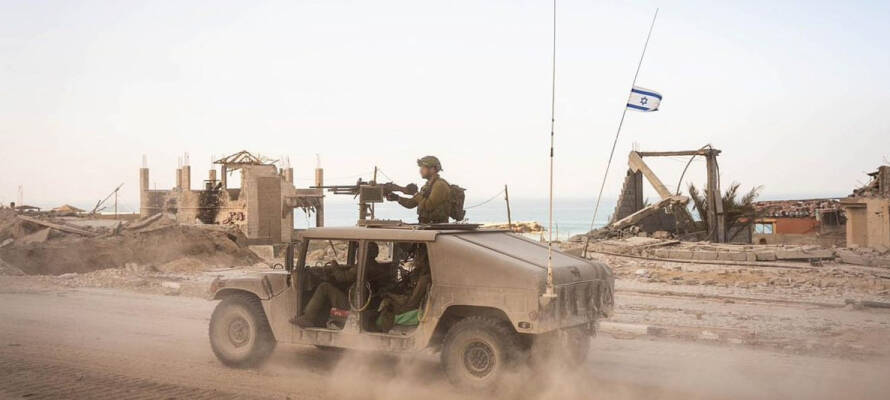The Rafah operation is expected to involve significant air and artillery strikes and tank movements.
By Yaakov Lappin, JNS
As the War Cabinet waits for a reply from Hamas to the latest far-reaching, unprecedented Israeli proposal for a hostage release deal, the IDF has drawn up operational plans for large-scale urban warfare in Hamas’s last remaining bastion in Rafah, southern Gaza.
These plans rely on the massive experience the IDF has gained over recent months while fighting in Gaza City and Khan Yunis, including the ability to evacuate masses of civilians.
The IDF will need to move over a million people out of Rafah, an ability it honed when it moved even more civilians out of Gaza City between October and December, but this time, the military will need to set up checkpoints and screen those leaving, to ensure that Hamas terrorists do not flee with civilians, as they did during the evacuation of Gaza City.
Like Gaza City, Rafah is a densely populated urban area, and the military will aim at dismantling Hamas’s infrastructure while seeking to avoid civilian casualties to the extent possible, with Hamas, as usual, entrenching itself within the population to use it as human shields.
The IDF is highly familiar by now in dealing with tunnels and overground terror facilities set up in civilian areas.
As part of its commitment to reduce harm to noncombatants—a goal the IDF always tries to meet, and one that the Biden administration continues to publicly pressure Israel on—the military will likely focus on large-scale evacuation of Gazan civilians well before the operation gets underway.
The IDF has marked out two evacuation zones: An expansion of the Al-Al-Mawasi zone along the central-southern Gazan coastline, and Khan Yunis.
Two divisions getting ready to attack
The 98th Paratroopers Division, which led the four-month operation in Khan Yunis, and the 162nd Armored Division, which spent six months fighting in central Gaza and setting up the Netzarim Corridor separating northern and southern Gaza, are expected to lead this operation.
Situational assessments, enhancing readiness in all areas, and commanders’ discussions: The 98th Division and the 162nd Division are preparing for continued combat in the Gaza Strip
On Tuesday, the military announced that these two divisions, both of which are currently out of Gaza, have been enhancing readiness and holding assessments, as well as holding sessions to draw conclusions from combat against Hamas thus far.
The two divisions reviewed combat procedures and plans for continued combat in the Gaza Strip, according to the IDF, while the headquarters of the divisions and of the brigades that operate within them, as well as reservist forces, held professional learning days at all operational levels to prepare for the continuation of their missions.
“The commanders of the divisions have completed the approval of plans for upcoming missions and are now continuing to enhance readiness in all areas and in training,” the IDF stated on Tuesday.
The IDF must draw up these plans while knowing that the fate of the hostages will be far from known under such a scenario, much like when a counterterror unit bursts into a home where hostages are being held.
The IDF cannot plan for every scenario but will need to take into account developments such as threats to the hostages made by Hamas leader in Gaza Yahya Sinwar, who is believed to be hiding in the tunnels of Rafah, or new attempts by Sinwar to stop the momentum of the IDF by making new overtures regarding a deal.
Assuming that the IDF may know the location of some of the hostages, the need to prevent strikes in those locations will be paramount, while the intelligence community will likely be monitoring events to see if new rescue operations become realistic during the operation.
On Feb. 12, the IDF rescued two Israeli hostages from their captivity in a Rafah apartment building.
The Rafah operation is expected to involve significant air and artillery strikes and tank movements.
In the rest of Gaza, the IDF is conducting targeted raids in the center and north of the Strip; any hostage deal that would freeze the military’s activities would see Hamas able to rebuild its forces.
Regardless of whether the operation goes ahead soon or further down the road due to a deal, Israel will need to be ready for the possibility that Hezbollah, which has already forced the military to fight on two fronts for the past six months, will escalate its attacks in the north to try and force Israel to divert military resources away from Gaza.
The Iranian-led terror axis does not want to see Israel destroy the remnants of the Hamas terror army, one of its most prized assets in the region, and could be willing to take new risks to try to save the Iranian-backed jihadist force in the Strip.
